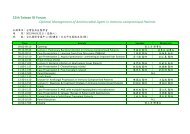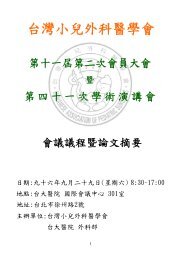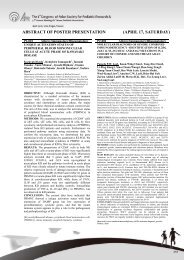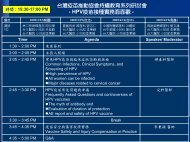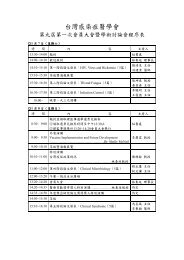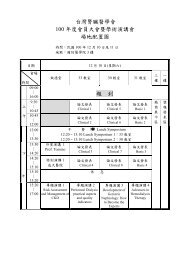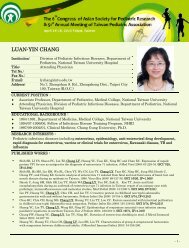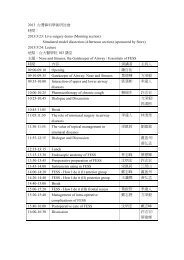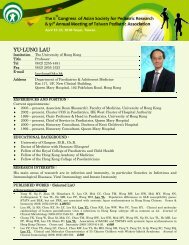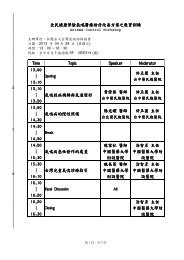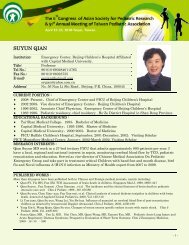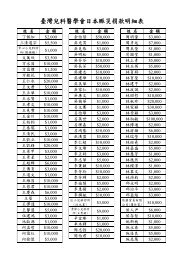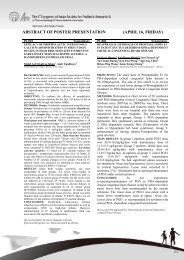ABSTRACT OF INVITED LECTURES AND ORAL PRESENTATION
ABSTRACT OF INVITED LECTURES AND ORAL PRESENTATION
ABSTRACT OF INVITED LECTURES AND ORAL PRESENTATION
- No tags were found...
Create successful ePaper yourself
Turn your PDF publications into a flip-book with our unique Google optimized e-Paper software.
FP9-02FLEXIBLE ENDOSCOPIC PLACEMENT <strong>OF</strong>TRACHEOBROCHIAL METALLIC STENT INCHILDREN —12 YEARS EXPERIENCEPei-Chen Tsao, *Wen-Jue Soong, Yu-Sheng Lee,Chia-Feng Yang, Yu-Yun Peng, Mei-Jy Jeng, Ren-BinTangDepartment of pediatrics, Taipei Veterans General Hospital, Taipei, Taiwan;Institute of Emergency and Critical Care Medicine, National Yang-MingUniversity, Taipei, TaiwanFP9-03COMPARISON BETWEEN CO 2 <strong>AND</strong> KTP LASERSUPRAGLOTTOPLASTY IN THE TREATMENT<strong>OF</strong> SEVERE LARYNGOMALACIA IN INFANTSWen-Jue Soong, An-Suey Shiao,* Yu-Shen Lee, Pei-ChenTsao, Chia-Feng Yang, Mei-Jy Jeng, Yu-Yun Peng, Ran-BinTangDepartment of Pediatrics, Department of ENT,* Taipei Veterans GeneralHospital, Taipei, Taiwan; Institute of Emergency and Critical Care Medicine,National Yang-Ming University, Taipei, Taiwan.OBJECTIVE: Placement of tracheobronchial (TB) stentcan be challengeable in children. Here we present our 12years experience of the feasibility, efficiency and safety ofthe balloon-expandable metallic stent placement by aid offlexible endoscopy (FE) in children.METHODS: It’s a retrospective analysis study in apediatric pulmonology training center. From Jan. 1998 toDec. 2009, all consecutive patients who had intra-TB stentimplantation were enrolled. Balloon-expandable metallicstent (Palmaz or IntraStent) insertions were performed withexclusively FE only, with nasopharyngeal oxygensupplement and pinch nose ventilation under intravenoussedation in our FE room.MAIN RESULTS: In 12-year-period, 81 stents wereplaced in 51 consecutive children. Mean age was 21.4 ±24.2 month-old and body weight was 11.0 ± 5.8 kg.Among them, 35 children were severe cardiopulmonarycompromised. Stents were placed in all locations withinthe central airways: 6 (7.4%) in subglottis, 47 in (58.0%)trachea, 3 (3.7%) cross carina in tracheobronchus, and 25(30.9%, Rt10, Lt 15) in bronchus. Underlying problemswere mainly for malacia (75.3%), and stenosis (24.7%).All these patients were already under respiratory support.In 27 pts the endotracheal tube (ETT) was removed justbefore the stent deployment procedure and neverre-intubated again afterward. Multiple stents were placed,either simultaneously or sequentially, in 22 pts due toeither multiple or complicated lesions. Total proceduretime was 25.2±8.1 min. All stents were employed with nodifficulty and no complication. Seventy-nine stents(97.5%) were successfully deployed in the target sites. Twostents had migration during deployment both occurred inthe early time of study. All patients, except 2 cases withstent slipped, had immediate symptomatic improvementafter the stenting.CONCLUSION: In children, even with severecompromised cardiopulmonary status, the metallic TBstent can be accurately, safely and successfully implantedby only using FE under intravenous sedation andappropriate ventilation management, without fluoroscopyor general anesthesia. It avoids radiation exposure and is acost-saving technique.[Keywords]airway stenosis, airway malacia, balloon-expandable stent,flexible bronchoscopy, tracheobronchial stentOBJECTIVE: Traditionally, severe laryngomalacia(SLM) is surgically treated with CO 2 laser via a rigidendoscopy (RE). The potassium-titanyl-phosphate (KTP)laser also works as a thermal vaporization. It can betransmitted via a flexible fiber and pass through aflexible endoscope (FE). The study analyze and comparethe clinical variables between two interventions, the CO 2laser via RE and the KTP laser via FE, in the treatmentof the SLM. IRB approved retrospective study ofconsecutive infants with SLM treated with lasersupraglottoplasty over a 4-year period.METHODS: All enrolled infants had undergone bilaterallaser supraglottoplasty. In the early 2-year period(2006-7), infants were treated with the traditional CO 2laser technique. In the later 2-year period (2008-9),infants were treated with a new novel technique of KTPlaser via a FE under intravenous sedation withouttracheal intubation. Clinical variables were comparedbetween these two groups.MAIN RESULTS: In 4-year period, total 57 infants (27 inCO 2 group, 30 in KTP group) were enrolled. There areno statistic differences of gender, age, body weight, andduration of post laser respiratory support between thetwo groups. Clinical improvement is also comparable,85.2% in CO 2 group and 86.6% in KTP group. However,there are significant shorter durations of the waiting timeof operation, operation time, ETT use, and total hospitaldays as well as less major complications in the KTPgroup.CONCLUSION: The technique of KTP laser via FE hascomparable success to that of the CO 2 laser via RE in thesupraglottoplasty of SLM in infant. It shows moreconvenient and favorable in no need of generalanesthesia and ETT intubation, therefore, can be doneimmediately after make diagnosis that actually can savetime and medical resources.[Keywords]carbon dioxide laser, KTP laser, laryngomalacia,supraglottoplasty88



